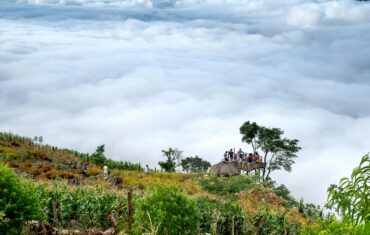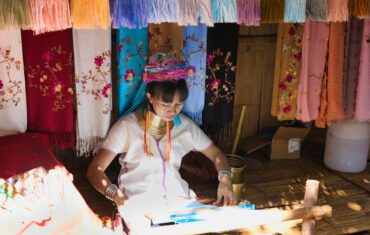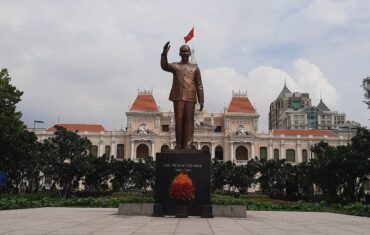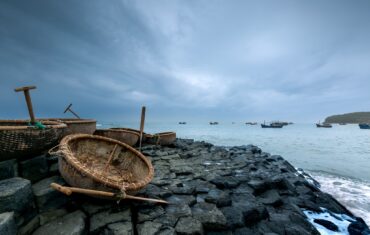Also known as the “Land of the Gods,” Bali captivates visitors with its sheer natural beauty, where towering volcanoes and lush terraced rice fields emanate a sense of peace and serenity. It is also renowned as a surfer’s paradise! Bali enchants with its dramatic dances, vibrant and colorful ceremonies, rich artistic traditions, exquisite craftsmanship, luxurious beach resorts, and thrilling nightlife. Everywhere you go, you will encounter intricately carved temples, showcasing the impeccable craftsmanship of the Balinese people.
THE GEOGRAPHY AND CLIMATE
As Bali is located 8 degrees south of the equator, you will find that the climate is typically tropical, warm, and humid throughout the year, with two distinct seasons: the dry season and the rainy season. Some areas around the central mountains of Bali (volcanoes) have peaks that reach over 3,000 meters above sea level. Up there, temperatures are considerably cooler, and it rains much more than in the coastal areas.
WHAT TO DO IN BALI
The white sandy beaches of Bali are undoubtedly a favorite destination for family vacations. There is a variety of water sports available, such as banana boat rides, parasailing, or jet skiing, as well as swimming or simply relaxing and enjoying the sun by the sea.
Kuta is one of the most famous beaches in Bali. Along this stretch, you’ll find a variety of hotels, restaurants, shops, and cafes. At night, the area comes alive with the rhythm of disco music.
For a quieter evening, enjoy the beach in Jimbaran, a popular spot to indulge in fresh grilled seafood. Seminyak is home to internationally renowned five-star hotels and luxury accommodations, filled with elegant dining venues. Sanur beach is also dotted with hotels and restaurants. You can also visit Nusa Dua, where you’ll find more private beaches in front of super-luxury hotels.
Surfers love the waves in Nusa Lembongan, near Nusa Penida. These islands are a 45-minute boat ride from Nusa Dua or Sanur. On the southwest coast of Nusa Penida, you’ll find Manta Point and Malibu Point, where divers can swim with trevallies, giant rays, and even sharks. Kelingking Beach, Atuh Beach, and Broken Beach are among the most famous spots in Nusa Penida.
The best diving spots can be found on the island of Menjangan, with its flat reef, anchor wreckage, eel garden, and caves to explore. Located in the western part of Bali, you can enjoy the rare sight of deer swimming near the beach. Pemuteran is also famous for its diving activities and its commitment to reef conservation.
Try exploring or hiking in West Bali National Park, where you can get up close to Bali’s rich flora and fauna, such as the Bali Starling or Bali Myna. Bali offers top-class white-water rafting along the spectacular Ayung River in Ubud. If you enjoy cycling, Ubud and its surroundings are a wonderful city to bike around, and there are also great cycling trails in Uluwatu in the south.
Mountaineers may want to climb Gunung Agung. Start your ascent from behind the temple or through the village of Sebudi. However, make sure to obtain permission from the temple authorities, as Balinese religion dictates that no one can stand higher than the sacred temple, especially during ceremonies.
Another mountain for your adventurous hike is the beautiful Mount Batur, which overlooks the serene Lake Batur in Kintamani.
CULTURE
The Balinese people follow a form of Hinduism known as Agama Hindu Dharma. The religion and cultural traditions of Bali have a profound impact on almost every aspect of life on the island, attracting people to Bali to witness and experience this rich heritage. A fundamental belief of Balinese Hinduism is that the elements of Mother Nature are influenced by divine spirits.
One of the most spectacular representations of Balinese culture is the Kecak dance, performed outdoors on a cliff at the Uluwatu Temple. Experience unforgettable moments as the sun slowly descends into the sea beyond this beautiful temple, while the Kecak dance provides an iconic artistic performance. The Kecak dance tells the story of the Ramayana, in which the wife of Prince Rama, Sita, is abducted by the demon king, Rahwana.
Being a vital part of Balinese culture, traditional Balinese dance is often associated with religious ceremonies. However, since the 1950s, with the rapid development of tourism, various modifications have been made, and dances are performed in activities outside of religious events. This has allowed visitors to appreciate and enjoy the rich artistic expression of Bali in different contexts.
CURRENCY
The official currency of Indonesia is the Indonesian Rupiah (IDR), issued and controlled by the Bank of Indonesia. The currency code for Rupiah is IDR, and the currency symbol is Rp. By law, all transactions must be conducted in Rupiah, and information about the daily exchange rate can be found in newspapers, online websites, and apps. Credit cards are widely accepted in hotels, upscale restaurants, and large stores.
ATMs connected to international networks such as Plus/Cirrus or Alto are common in major cities and tourist destinations in Indonesia. The withdrawal limit depends on your respective issuing bank. These ATMs dispense bills in denominations of IDR50,000 or IDR100,000, as indicated on the machine. However, it’s important to note that larger denomination bills can be more difficult to break, especially in non-touristic rural areas. It is advisable to withdraw some cash from an ATM in major cities before venturing into more remote destinations.
HEALTHCARE
Balinese people have always valued cleanliness and hygiene. Bathing is a bi-daily ritual for them. It is also a time when they visit the river, where women wash their family’s clothes. This becomes a meeting place for men and women, with men upstream and women downstream. There are many stories surrounding this tradition, some filled with playful encounters and others involving daring escapes. One extraordinary tale is that of Lod-lod Peng, a character with a truly fascinating, albeit somewhat unsettling, story from a woman’s perspective. He was said to possess a very peculiar and elongatable phallus, which he could control at will. This phallus would then slither like a serpent through the water, submerge, and reemerge alongside the woman of his choice. Just imagine the scene, filled with mystery and intrigue.
TRANSPORTATION
Bali is relatively small in size, but it can take a considerable amount of time to travel across the island. Public transportation is sporadic, so choosing the most efficient way to get around is crucial in the “Island of the Gods.” Traffic jams are common in densely populated areas in the south and central parts of the island, which are popular gathering spots for travelers and tourists. In the peripheral rural areas, the winding roads through rice fields and the irregular chains of hills and valleys make exploring the island a delight, but they also contribute to slowing down the pace. Bali is a place where rushing is rarely worth it.
VISA AND TOURISM
Since the end of 2021, Bali has gradually been opening its doors to international tourists. On March 7, 2022, the government implemented a quarantine-free trial period and a Visa On Arrival (VOA) program for 23 selected countries. The list of countries was then expanded to 42 on March 22, 2022, 43 countries on April 6, 2022, 60 countries on April 28, 2022, 72 countries on May 30, 2022, and finally 75 countries on July 27, 2022. Currently, there are 86 countries on the list as of the update on September 23, 2022. For more details, you can check the following link: HERE
GASTRONOMY
Culinary tradition is an inseparable part of Indonesia’s cultural heritage, shaped by a long lineage of local ingredients and culinary techniques. Innovative creations sometimes fuse local ingredients with cooking techniques from other cultures, resulting in new ways to satisfy a wider and international audience’s appetite. Tourism is closely related to gastronomic adventures and shopping experiences. Apart from the beautiful beaches and other tourist sites, Bali also boasts several delicious traditional cuisines.
Betutu is a Balinese dish of chicken or duck, steamed or roasted, enriched with a blend of Betutu spices. This highly seasoned and spiced dish is very popular in Bali and Lombok. Betutu spice blends consist of shallots, garlic, turmeric, ginger, wild ginger, galangal, candle nuts, hot chili peppers, shrimp paste, and peanuts, all finely ground in a mortar. The mixture is then sautéed and applied to the poultry. The tastes and cooking methods of Betutu can vary across different regions of Bali.
Sate Lilit is a variant of satay in Balinese cuisine. It is made from minced pork, fish, chicken, beef, or even turtle, which is then mixed with grated coconut, thick coconut milk, lemon juice, shallots, and pepper. The spiced minced meat is wrapped around bamboo skewers, sugar cane, or lemongrass, and then grilled over charcoal. The term “lilit” means “to wrap,” which corresponds to its method of wrapping the meat instead of skewering it.
Babi Guling or roasted pig in Bali is usually served with lawar and steamed rice. It is one of the most famous dishes in Bali. The pig is stuffed and infused with a spicy concoction, which typically consists of turmeric, coriander seeds, lemongrass, black pepper, and garlic, and traditionally roasted on a spit. It is available in warungs, where locals go for a quick lunch or dinner.
Lawar is a dish made from a mixture of vegetables, coconut, and minced meat blended with rich herbs and spices. It is commonly found in restaurants and warungs in Bali. Despite its rich vegetable blend, Lawar is not a vegetarian dish, as it is often mixed with minced meat or even blood.
Rujak Bulung (seaweed) is one of the favorite dishes of the Balinese people. Finding Rujak Bulung won’t be too demanding, as it can be easily found at many stalls selling local Balinese cuisine. Besides its delicious taste, Balinese people generally consume this dish when experiencing nausea due to its ability to relieve sickness and vomiting.
The gastronomy of Bali offers a diverse range of flavors and authentic culinary experiences that will captivate food lovers and travelers in search of new gastronomic adventures.
BEST TIME TO VISIT BALI
If you’re planning a trip to Bali, the best time to visit is between April and October, during the island’s dry season. Bali experiences only two seasons: the rainy season and the dry season. Throughout the year, daytime temperatures range from the mid-80s to 90s, with the main difference being the patterns of humidity and precipitation. The lack of rain during the summer season makes Bali more comfortable for beachgoers.
From November to March, Bali receives a significant amount of rainfall. In fact, January sees very few days without drizzle. While the rain may not be enough to deter you, the combination of high humidity and temperatures (an average of 90 degrees Fahrenheit during the day) might make you reconsider a visit during the low season. Another inconvenience of the rain is decreased visibility at diving sites in the region and relentless mosquitoes. That being said, if you’re looking for bargains, you’ll have better luck during this time.
Keep in mind that each season has its own charm in Bali, but if you want to enjoy sunny beaches and explore the island without interruptions due to rain, planning your visit during the dry season is an excellent choice. Get ready for an unforgettable experience on this beautiful island!









